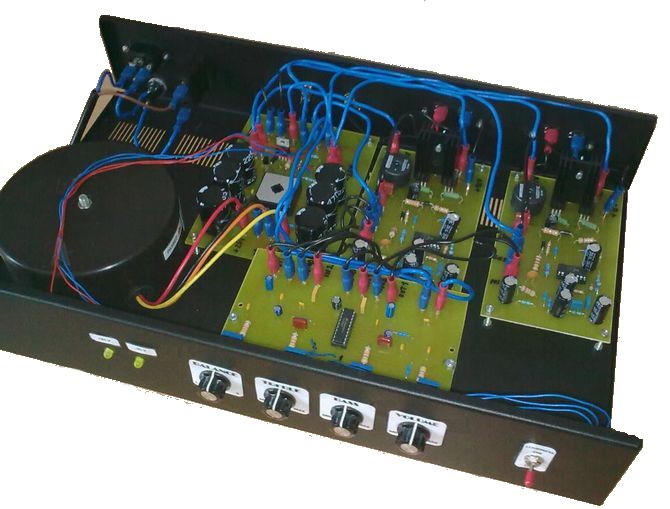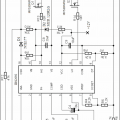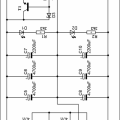
IRS2092 2X50W Class D Amplifier Project The objective of this work is the design and implementation of the amplifier of class D with an output power 2 x 50 W at the impedance load of 4 Ω and a maximum total harmonic distortion of 10 %. In work is described the principle of operation of amplifiers of class D and are dismembered their sub-blocks. In the other chapters is then made the proposal alone amplifiers. Therefore, the proposal of the preamp, power stage, output filter and also the power supply. The basic principles of audio amplifiers working in class D are known for a number of years. Over time, the topology of these devices modified and refined up to the present forms. Amplifiers of class D are mainly used due to its high efficiency. The application most commonly found in battery-powered systems such as cell phones, MP3 players or laptops.
Class D Amplifier IRS2092 Circuit

The involvement of the preamplifier Circuit LM1036 uses to control the dc voltage of the internal reference source formed by Zener diode 5,4 In. The voltage from the diode goes to the pin no. 17, to which are connected the potentiometers POT1 – POT4. Potentiometer POT1 will control the depth, potentiometer POT2 volume, potentiometer POT3 controls the balance and stereo image, and a potentiometer POT4 controls the height. A reference voltage is further governed by physiological compensation volume “loudness controll”, which enable the connection of pins 7 and 12 with the switch S1. For suppression of interfering components in the control circuit.

The circumference of the IRS2092 from the company International Rectifier is designed for control of power transistors MOSFET. In addition to the PWM modulator and exciter transistors is equipped with overcurrent protection and delay circuit, which in turn removes the uncomfortable surges of the speaker.

As the output filter is used filter type low-pass filter consisting of a coil and a capacitor. The involvement of the filter. For the load 4 Ω, the manufacturer of the circuit IRS2092 recommended use the coil of inductance of 22µH and a capacitor of 0.47 µF. The cutoff frequency of the assembled filter we can verify this by using Thompson’s relationship.
![]() class d amp irs2092 circuit pcb schematic all files alternative links:
class d amp irs2092 circuit pcb schematic all files alternative links:
FILE DOWNLOAD LINK LIST (in TXT format): LINKS-25618.zip
Published: 2016/06/08 Tags: audio amplifier circuits, class d amplifier circuit, transistor amplifier



NCP1380 Flyback SMPS Circuit 12V 5.8A
NCP1380 fixed switching frequency of the driven circuit NCP1236 and changer using the effect of switching at a minimum voltage (valley switching) with the controller NCP1380. For the needs of comparison was designed a test board with NCP1380. Design resources comes from the 65 W adapter with controller NCP1236 described in the application note . Unchanged was taken as the input of the EMI filter, a power circuit, a feedback circuit with a TL431 and a large part of the motive circuit.
IRS2092 Klasse-D Verstärker Schaltung LM1036 Klangregelung
IRS2092 2X50W Klasse-D Verstärker Projekt Das Ziel dieser Arbeit ist die Konzeption und Umsetzung der Verstärker der Klasse D mit einer Ausgangsleistung von 2 x 50 W an die Last-Impedanz von 4 Ω und einem maximalen Klirrfaktor von 10 %. In der Arbeit wird beschrieben, das Prinzip der Betrieb von Verstärkern der Klasse D und zerstückelt Ihre sub-Blöcke. In den weiteren Kapiteln wird dann den Vorschlag gemacht allein Verstärker. Daher der Vorschlag, den Vorverstärker, Endstufe, Ausgang filter und auch die Stromversorgung. Die grundlegenden Prinzipien der audio-Verstärker arbeitet im class-D sind bekannt für eine Reihe von Jahren. Im Laufe der Zeit, die Topologie, die diese Geräte modifiziert und verfeinert bis zu den heutigen Formen. Verstärker der Klasse D werden hauptsächlich wegen Ihrer hohen Effizienz. Die Anwendung meist in batteriebetriebenen Systemen, wie Handys.